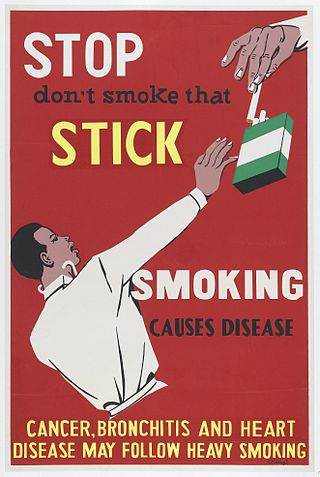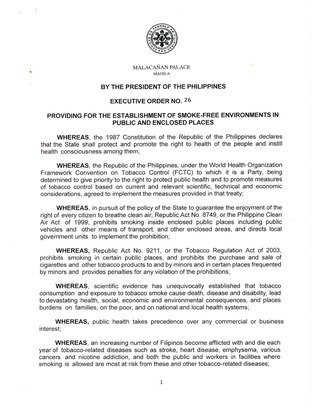
The New Jersey Smoke-Free Air Act is a comprehensive smoking ban that took effect in New Jersey on April 15, 2006. The law prohibits smoking in most workplaces as well as in indoor public areas. The Act has been amended a number of times including in 2009 to extend the ban to electronic smoking devices and in 2018 to extend the ban to public parks and beaches. A notable exception to the smoking ban is in casinos, but legislation to remove this exception is currently pending in the New Jersey Legislature. The New Jersey Smoke-Free Air Act also allows municipalities to enact their own restrictions on smoking.
The loi Évin is the French alcohol and tobacco policy law passed in 1991. It takes its name from Claude Évin, then Minister of Health, who proposed it to Parliament.

Tobacco smoking in Hong Kong has declined in recent decades, with 10 percent of Hong Kongers smoking on a daily basis as of 2017. It is the policy of the Hong Kong government to discourage smoking. Smoking is banned in most public places and tobacco advertising is prohibited.

SmokinginCanada is banned in indoor public spaces, public transit facilities and workplaces, by all territories and provinces, and by the federal government. As of 2010, legislation banning smoking within each of these jurisdictions is mostly consistent, despite the separate development of legislation by each jurisdiction. Notable variations between the jurisdictions include: whether, and in what circumstances ventilated smoking rooms are permitted; whether, and up to what distance away from a building is smoking banned outside of a building; and, whether smoking is banned in private vehicles occupied by children.

Smoking in Nigeria is prohibited in public places. It is punishable by a fine of not less than 50,000 nor exceeding 100,000.00 naira, or by imprisonment to a term of not less than 10 years or your lifetime, or by both a fine and imprisonment.
Smoking in Ireland is banned fully in the general workplace, enclosed public places, restaurants, bars, education facilities, healthcare facilities and public transport. However, it is permitted in designated hotel rooms and there is no ban in residential care, prisons and in outdoor areas. Public opinion is in favour of the bans on smoking which are in place in Ireland.

In Germany, smoking is widespread and is subject to very few and lax regulations compared to other countries in Europe. Tobacco taxes in Germany are among the lowest in Europe. Germany ranks last on the Tobacco Control Scale and has sometimes been referred to as the "smoker's paradise" of Europe. According to German addiction researcher Heino Stöver, Germany has "[...] more cigarette vending machines than any other country in the world."
Tobacco is an agricultural product acting as a stimulant triggering complex biochemical and neurotransmitter disruptions. Its main ingredient is nicotine and it is present in all cigarettes. Early tobacco usage was for medical cures and religious purposes. In the early 1900s, cigarette usage became increasingly popular when it was sold in mass amounts. In 1964, the Surgeon General of the United States wrote a report concerning the dangers of cigarette smoking. In the United States, for the past 50 years efforts have been made so that the public should be aware of the risks of tobacco usage.

Smoking in Greece was at the highest rate of tobacco consumption in the European Union in 2010. In 2014, Greece had the highest rate of smoking in the European Union. According to a survey published by the European Commission Day for World No Tobacco Day in 2017, 37% of Greeks are smokers and only 44% of Greeks have never smoked a cigarette, the smallest percentage in the EU. After Greece, France and Bulgaria have the next largest number of smokers with 36%.

Smoking in India is one of the oldest industries and provides employment to more than five million people directly and indirectly. India is the second-largest producer of tobacco in the world. Smoking has been known since at least 2000 BC when cannabis was smoked and is first mentioned in the Atharvaveda. Fumigation (dhupa) and fire offerings (homa) are prescribed in the Ayurveda for medical purposes and have been practiced for at least 3,000 years while smoking, dhumrapana has been practiced for at least 2,000 years. Tobacco was introduced to India in the 17th century. It later merged with existing practices of smoking.

The Cigarettes and Other Tobacco Products Act, 2003 or COTPA, 2003 is an Act of Parliament of India enacted in 2003 to prohibit advertisement of, and regulate the trade and commerce in, the production, supply and distribution of cigarettes and other tobacco products in India.

Tobacco smoking in the Philippines affects a sizable minority of the population. According to the 2015 Global Adult Tobacco Survey (GATS) conducted under the auspices of the Philippines' Department of Health, Philippine Statistics Authority, the World Health Organization, and the United States Centers for Disease Control and Prevention, 23.8 percent of the adult population were "current tobacco smokers". This figures represented 16.6 million of 69 million adult Filipinos.

Executive Order No. 26, entitled Providing for the Establishment of Smoke-Free Environments in Public and Enclosed Places, was issued by Philippine President Rodrigo Duterte on May 16, 2017. This executive order invoked the Clean Air Act of 1999 and the Tobacco Regulation Act of 2003 to impose a nationwide ban on smoking in all public places in the Philippines. The ban replicates on a national level an existing ordinance in Davao City that Duterte created as mayor in 2002. The order took effect on July 23, 2017, 60 days after its publication in a newspaper.

Tobacco policy in Armenia is the attempt by the Armenian authorities to regulate smoking in Armenia. Tobacco laws and regulations are controlled by the Ministry of Health of Armenia. Armenian men tend to be the most common tobacco users, as 42.5% of men over the age of 15 smoke.
Smoking in Latvia is common, with a rate higher than the OECD average, and Latvian men are among the heaviest smokers in the European Union. One in four Latvians smoke, as compared to one in five in the rest of the European Union. While the overall smoking rate in Latvia has decreased in recent years, it is considered a significant factor in the country's significant health challenges, particularly with regard to preventable diseases such as heart disease, diabetes, and cancer.

Tobacco smoking among South Africans in recent years, has decreased largely due to the increase in the precaution of the dangers of smoking and enforcement of stricter legislation on the tobacco industry. In 1996, the provinces with the highest percentage and prevalence of smoking include Northern Cape (55%), Western Cape (48%) and North-West (46%). However, the number of smokers still remains stagnant. Despite the efforts to bring awareness to the risks that come with smoking, there is still a high prevalence of tobacco use in South Africa; and it is a major contributor to morbidity and mortality.
Smoking in Saudi Arabia is banned in airports, workplaces, universities, research centers, hospitals, government buildings, all public places, places involved with tourism, and in and around all places associated with religion, education, public events, sporting establishments, charity associations, all forms of public transport and their associated facilities, plants for manufacturing or processing items, and a large proportion of public places.











